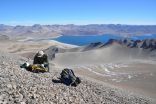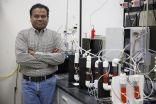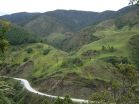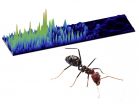Glassy protein solution may cause eyesight deterioration
2014-11-26
(Press-News.org) Long-sightedness caused by age could be due to proteins in the lens of the eye that are converted from a fluid solution to a solid, glassy state. This has been shown in a study by researchers from institutions including Lund University.
Around the age of 40-50, many people find their sight deteriorates and they need to use reading glasses. This age-related long-sightedness is thought to be due to a reduction in the elasticity of the lens in the eye. A new research study appears to have put its finger on the details of what happens in the eye when long-sightedness develops.
"This feels like an exciting discovery. We now intend to continue studying the behaviour of protein mixtures that resemble the interior of the eye lens", said Anna Stradner, an associate professor at Lund University.
Working with Professor Peter Schurtenberger at Lund University and international research colleagues, she has studied the protein that occurs most commonly in the lens of the eye, alpha-crystallin. The results of the study show that, at high concentrations, solutions of this protein undergo a transition from a fluid form to a glassy state. What happens is that the protein becomes less mobile at high concentrations, which leads to the transition from a fluid to a solid form. This could be the reason why the lens of the eye becomes more rigid with age.
The study also suggests a link to another eye condition, cataract which is an eye disease in which the lens becomes cloudy and less transparent. The researchers believe that cataract formation may be influenced by the reduced movement of the protein in the lens when the glassy state occurs.
Anna Stradner and her colleagues now hope that their findings will lead to further studies that can help to improve understanding of age-related long-sightedness and cataract at a molecular level. The present study has recently been published in the scientific journal PNAS.
INFORMATION:
ELSE PRESS RELEASES FROM THIS DATE:
2014-11-26
How do the genes in the cells inside the body's muscles respond when the muscles are put to work? And how are these genes affected when muscles are not used? What importance do activity and, on the other hand, lack of activity have for the organism's metabolism, and thus also for diseases such as diabetes and obesity?
These questions form the basis for a new study from the Department of Public Health at Aarhus University and the Institute of Sports Medicine at Bispebjerg Hospital. For the first time, the study compares the reactions of all genes in the muscles to diverse ...
2014-11-26
Boulder, Colorado, USA - The Laguna del Maule Volcanic Field, Chile, includes a record of unusually large and recent concentration of silicic eruptions. Since 2007, the crust there has been inflating at an astonishing rate of 25 centimeters per year. This unique opportunity to investigate the dynamics of a large rhyolitic system while magma migration, reservoir growth, and crustal deformation are actively under way is stimulating a new international collaboration.
Explosive eruptions of large-volume rhyolitic magma systems are common in the geologic record and pose a ...
2014-11-26
GAINESVILLE, Fla. --- Buck Rogers surely couldn't have seen this one coming, but at NASA's request, University of Florida researchers have figured out how to turn human waste -- yes, that kind -- into rocket fuel.
Adolescent jokes aside, the process finally makes useful something that until now has been collected to burn up on re-entry. What's more, like so many other things developed for the space program, the process could well turn up on Earth, said Pratap Pullammanappallil, a UF associate professor of agricultural and biological engineering.
"It could be used on ...
2014-11-26
DESPITE a sequence of stellar performances by Britain's female athletes and team game players, coverage of women's sport in the Press still occupies a fraction of the space given to men, according to University of Huddersfield lecturer Deirdre O'Neill, who has analysed thousands of articles in newspapers that she describes as a "football-saturated boyzone".
One side effect of this marginalisation of women's sport is that girls - with fewer role models to admire - are much less likely to take part themselves. They leave school half as active as young men, leading to potential ...
2014-11-26
Bioengineers at the University of California, San Diego have discovered that mouse embryos are contemplating their cellular fates in the earliest stages after fertilization when the embryo has only two to four cells, a discovery that could upend the scientific consensus about when embryonic cells begin differentiating into cell types. Their research, which used single-cell RNA sequencing to look at every gene in the mouse genome, was published recently in the journal Genome Research. In addition, this group published a paper on analysis of "time-course"single-cell data ...
2014-11-26
Latest research on the oldest surviving rock art of Southeast Asia shows that the region's first people, hunter-gatherers who arrived over 50,000 years ago, brought with them a rich art practice.
Published this week in the archaeological journal Antiquity, the research shows that these earliest people skilfully produced paintings of animals in rock shelters from southwest China to Indonesia. Besides these countries, early sites were also recorded in Thailand, Cambodia and Malaysia.
Griffith University Chair in Rock Art Professor Paul Taçon led the research which ...
2014-11-26
A Brigham and Women's Hospital-led team has identified a long sought-after partner for a key immune protein, called TIM-3, that helps explain its two-faced role in the immune system -- sometimes dampening it, other times stimulating it. This newly identified partner not only sheds light on the inner workings of the immune system in diseases such as HIV, autoimmunity, and cancer, but also provides a critical path toward the development of novel treatments that target TIM-3. The researcher's findings appeared last month in the journal Nature.
"There has been a lot of confusion ...
2014-11-26
Conservationists are always looking for ways to halt the pace of deforestation in tropical rainforests. One approach involves recultivating abandoned agricultural land. An international team* investigating this concept has just published its findings in Nature Communications. Working in the mountainous regions of Ecuador, the researchers found afforestation and intense pasturing to be particularly effective, clearly increasing the environmental and economic value of abandoned farmlands.
Every year, 130,000 square kilometers of rainforest disappear from the face of the ...
2014-11-26
This news release is available in German.
A drunken sailor staggers onto a square with lots of streetlamps on it. Sometimes he will run into one of the lamps, change his direction and keep moving. Does the time he spends on this square depend on the number of streetlamps? The surprising answer is: no.
No matter whether there is a streetlamp on every square meter or whether the distance between the lamps is large: on average, the drunken sailor will always spend the same amount of time on the square. Calculations at the Vienna University of Technology (TU Wien) ...
2014-11-26
Neither quantum computers nor quantum cryptography will become prevalent technologies without memory systems able to manipulate quantum information easily and effectively. The Faculty of Physics at the University of Warsaw has recently made inroads into popularizing quantum information technologies by creating an atomic memory with outstanding parameters and an extremely simple construction.
Following years of tests in physics laboratories, the first quantum technologies are slowly emerging into wider applications. One example is quantum cryptography - an encryption ...
LAST 30 PRESS RELEASES:
[Press-News.org] Glassy protein solution may cause eyesight deterioration






